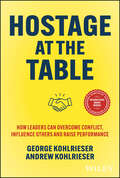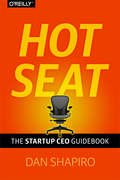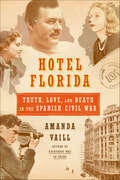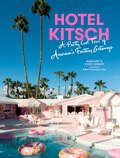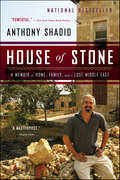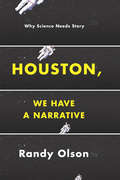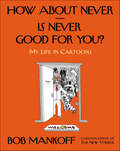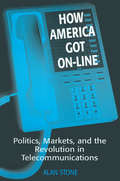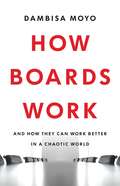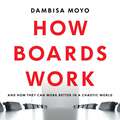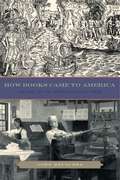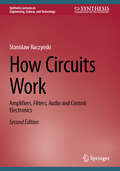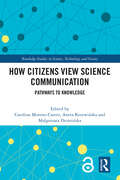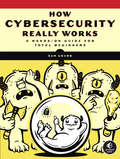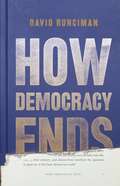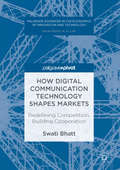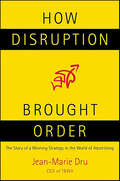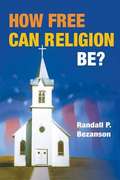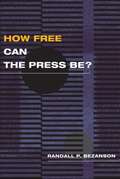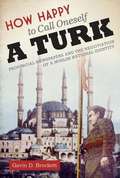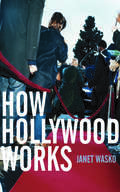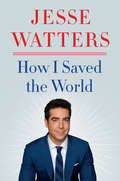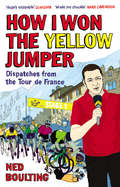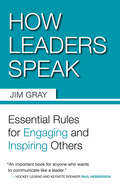- Table View
- List View
Hostage at the Table: How Leaders Can Overcome Conflict, Influence Others and Raise Performance
by George Kohlrieser Andrew KohlrieserDiscover how to boldly lead, address conflict and inspire others in your business and personal life In the newly revised second edition of Hostage at the Table: How Leaders Can Overcome Conflict, Influence Others and Raise Performance, clinical psychologist, distinguished leadership professor, and veteran hostage negotiator George Kohlrieser comes together with his son Andrew Kohlrieser, an experienced leadership, negotiation and conflict resolution consultant, to deliver another incisive and practical discussion of how to use the proven psychological techniques used in hostage negotiations to enhance your leadership skills both professionally and personally. Step-by-step, the authors explain the seven key factors that anyone can use to remove the obstacles that stand in the way of resolving interpersonal, business and leadership issues. You’ll: ● Discover proven techniques for interpersonal and business conflict management ● Become a secure base for your team, establish trust, and learn how to bond with anyone ● Explore how to identify where you are holding yourself hostage in your life and learn how to reclaim your agency and move toward a more empowered future A fascinating and hands-on presentation of how to take the lessons drawn from tense, high-stakes hostage situations and apply them to the interpersonal and leadership problems you face every day, Hostage at the Table is a must-read resource for managers, executives, entrepreneurs, founders, and other business leaders seeking the latest research, the most engrossing real-world negotiation examples, and the most effective solutions.
Hot Seat: The Startup CEO Guidebook
by Dan ShapiroWhat avoidable problem destroys more young startups than any other?Why is it a mistake to ask for introductions to investors?When do you play the CEO card?Should you sell out?Author and four-time founder/CEO Dan Shapiro tells the stories of dozens of startups whose companies lived and died by the advice in these pages. From inception to destruction and triumph to despair, this rollercoaster read takes aspiring entrepreneurs from the highs of billion-dollar payouts and market-smashing success to the depths of impostor syndrome and bankruptcy.Hot Seat is divided into the five phases of the startup CEO experience:Founding explains how to formulate your idea, allocate equity, and not argue yourself to deathFunding provides the keys to venture capital, angels, and crowdfunding, plus clear advice on which approach to chooseLeadership lays out a path to build a strategy and culture for your team that will survive good times and badManagement reveals how to manage your board, argue with your team, and play the CEO cardEndgame explains how to finish a company's existence with grace, wealth, and minimal litigation
Hotel Florida: Truth, Love, and Death in the Spanish Civil War
by Amanda VaillA spellbinding story of love amid the devastation of the Spanish Civil WarMadrid, 1936. In a city blasted by a civil war that many fear will cross borders and engulf Europe—a conflict one writer will call "the decisive thing of the century"—six people meet and find their lives changed forever. Ernest Hemingway, his career stalled, his marriage sour, hopes that this war will give him fresh material and new romance; Martha Gellhorn, an ambitious novice journalist hungry for love and experience, thinks she will find both with Hemingway in Spain. Robert Capa and Gerda Taro, idealistic young photographers based in Paris, want to capture history in the making and are inventing modern photojournalism in the process. And Arturo Barea, chief of the Spanish government's foreign press office, and Ilsa Kulcsar, his Austrian deputy, are struggling to balance truth-telling with loyalty to their sometimes compromised cause—a struggle that places both of them in peril. Beginning with the cloak-and-dagger plot that precipitated the first gunshots of the war and moving forward month by month to the end of the conflict. Hotel Florida traces the tangled and disparate wartime destinies of these three couples against the backdrop of a critical moment in history: a moment that called forth both the best and the worst of those caught up in it. In this noir landscape of spies, soldiers, revolutionaries, and artists, the shadow line between truth and falsehood sometimes became faint indeed—your friend could be your enemy and honesty could get you (or someone else) killed. Years later, Hemingway would say, "It is very dangerous to write the truth in war, and the truth is very dangerous to come by." In Hotel Florida, from the raw material of unpublished letters and diaries, official documents, and recovered reels of film, the celebrated biographer Amanda Vaill has created a narrative of love and reinvention that is, finally, a story about truth: finding it, telling it, and living it—whatever the cost.*INCLUDES 16 PAGES OF BLACK-AND-WHITE PHOTOGRAPHS
Hotel Kitsch: A Pretty Cool Tour of America's Fantasy Getaways
by Margaret Bienert Corey BienertA visual celebration of the best fantasy suites and honeymoon hotels across America and beyond, from the creators of A Pretty Cool Hotel Tour In 1963, the savvy owners of the Cove Haven Resort in the Poconos unveiled their heart-shaped tub. Like Elvis Presley and Playboy magazine, it launched a postwar phenomenon that defined a new era of pop pleasure: the honeymoon hotel. Destinations across the country were soon racing to catch up, installing not just heart-shaped tubs but all types of over-the-top design flourishes, from pink shag carpeting to immersive worlds worthy of a Broadway stage set, in order to create a sense of romance, fantasy, even adventure. From the photographers and inveterate travelers behind the social media sensation A Pretty Cool Hotel Tour, Hotel Kitsch celebrates dozens of creative, nostalgic, one-of-a-kind hotels that span the heart of the Poconos and across the United States to Mexico, Spain, and the UK. Discover, in the middle of Iowa, a jungle room with fake trees and foliage surrounding the bed as if it had taken its cue from Where the Wild Things Are. Or Jules&’ Undersea Lodge in Key Largo where the rooms are reached by scuba diving. An Arctic Cave room at a hotel in Kentucky with its carved blue walls and not a window to be found. And on the California coast, the iconic Madonna Inn featuring 110 rooms, each themed and no two alike. Along the way, authors Margaret and Corey Bienert uncover too many wild details to mention, including unconventional beds (a Cadillac, a clamshell, a sandwich), mirrors on mirrors on mirrors, in-room swimming pools, full suits of armor, and fiber-optic star ceilings. While it&’s not a travel guide, every destination in Hotel Kitsch is open for business. Time to check in.
House of Stone: A Memoir of Home, Family, and a Lost Middle East
by Anthony Shadid“Wonderful . . . One of the finest memoirs I’ve read.” — Philip Caputo, Washington PostIn the summer of 2006, racing through Lebanon to report on the Israeli invasion, Anthony Shadid found himself in his family’s ancestral hometown of Marjayoun. There, he discovered his great-grandfather’s once magnificent estate in near ruins, devastated by war. One year later, Shadid returned to Marjayoun, not to chronicle the violence, but to rebuild in its wake.So begins the story of a battle-scarred home and a journalist’s wounded spirit, and of how reconstructing the one came to fortify the other. In this bittersweet and resonant memoir, Shadid creates a mosaic of past and present, tracing the house’s renewal alongside the history of his family’s flight from Lebanon and resettlement in America around the turn of the twentieth century. In the process, he memorializes a lost world and provides profound insights into a shifting Middle East. This paperback edition includes an afterword by the journalist Nada Bakri, Anthony Shadid’s wife, reflecting on his legacy.“A poignant dedication to family, to home, and to history . . . Breathtaking.” — San Francisco Chronicle“Entertaining, informative, and deeply moving . . . House of Stone will stand a long time, for those fortunate enough to read it.” — Telegraph (London)
Houston, We Have a Narrative: Why Science Needs Story
by Randy OlsonAsk a scientist about Hollywood, and you'll probably get eye rolls. But ask someone in Hollywood about science, and they'll see dollar signs: moviemakers know that science can be the source of great stories, with all the drama and action that blockbusters require. That's a huge mistake, says Randy Olson: Hollywood has a lot to teach scientists about how to tell a story--and, ultimately, how to do science better. With Houston, We Have a Narrative, he lays out a stunningly simple method for turning the dull into the dramatic. Drawing on his unique background, which saw him leave his job as a working scientist to launch a career as a filmmaker, Olson first diagnoses the problem: When scientists tell us about their work, they pile one moment and one detail atop another moment and another detail--a stultifying procession of "and, and, and. " What we need instead is an understanding of the basic elements of story, the narrative structures that our brains are all but hardwired to look for--which Olson boils down, brilliantly, to "And, But, Therefore," or ABT. At a stroke, the ABT approach introduces momentum ("And"), conflict ("But"), and resolution ("Therefore")--the fundamental building blocks of story. As Olson has shown by leading countless workshops worldwide, when scientists' eyes are opened to ABT, the effect is staggering: suddenly, they're not just talking about their work--they're telling stories about it. And audiences are captivated. Written with an uncommon verve and enthusiasm, and built on principles that are applicable to fields far beyond science, Houston, We Have a Narrative has the power to transform the way science is understood and appreciated, and ultimately how it's done.
How About Never—Is Never Good for You?: My Life in Cartoons
by Bob MankoffMemoir in cartoons by the longtime cartoon editor of The New YorkerPeople tell Bob Mankoff that as the cartoon editor of The New Yorker he has the best job in the world. Never one to beat around the bush, he explains to us, in the opening of this singular, delightfully eccentric book, that because he is also a cartoonist at the magazine he actually has two of the best jobs in the world. With the help of myriad images and his funniest, most beloved cartoons, he traces his love of the craft all the way back to his childhood, when he started doing funny drawings at the age of eight. After meeting his mother, we follow his unlikely stints as a high-school basketball star, draft dodger, and sociology grad student. Though Mankoff abandoned the study of psychology in the seventies to become a cartoonist, he recently realized that the field he abandoned could help him better understand the field he was in, and here he takes up the psychology of cartooning, analyzing why some cartoons make us laugh and others don't. He allows us into the hallowed halls of The New Yorker to show us the soup-to-nuts process of cartoon creation, giving us a detailed look not only at his own work, but that of the other talented cartoonists who keep us laughing week after week. For desert, he reveals the secrets to winning the magazine's caption contest. Throughout How About Never--Is Never Good for You?, we see his commitment to the motto "Anything worth saying is worth saying funny."
How America Got On-line: Politics, Markets, and the Revolution in Telecommunication
by Alan StoneThe telecommunications industry is the fastest growing sector of the US economy. This interdisciplinary study of technopolitical economics traces the industry's evolution from the invention of the telephone to the development of hypercommunications. Primary focus is on AT&T and its rivals.
How Australia Decides
by Sally YoungIn recent years, the Australian media have come under fire for their reporting of politics and election campaigns. Political reporting is said to be too influenced by commercial concerns, too obsessed with gossip and scandal, and too focused on trivia and 'sound bites' at the expense of serious issues. There are accusations of bias, sensationalism, 'lazy' journalism and 'horse-race' reporting that is obsessed with opinion polls. How Australia Decides is the first book to put these allegations to the test. Based on a four-year empirical study, Sally Young reports the results of the only systematic, historical and in-depth analysis of Australian election reporting. This groundbreaking book shows how election reporting has changed over time, and how political news audiences, news production and shifts in political campaigning are influencing media content, Ai with profound implications for Australian democracy.
How Boards Work: And How They Can Work Better in a Chaotic World
by Dambisa Moyo'Highly instructive . . . provides thoughtful analysis' Financial Times'Exactly what any prospective-or sitting-board member needs' Arianna Huffington'A must read . . . highly engaging . . . an indispensable guide to how boards function, malfunction, and, most importantly, should operate better' Mohamed A. El-ErianCorporate boards are under great pressure. Scandals and malpractice at companies like GE, Theranos and WeWork have raised justified questions among regulators, shareholders, and the public about the quality of corporate governance. Boards face ever-louder demands to weigh in on questions of climate change, racial and gender equity, data privacy, and other social issues that range far beyond their traditional mandate: choosing the CEO and endorsing corporate strategy.In HOW BOARDS WORK, prizewinning economist, veteran board director, and bestselling author Dambisa Moyo offers an insider's view of corporate boards as they are buffeted by the turbulence of our times. Drawing on her decade of experience serving on corporate boards, Moyo lays out what it is that boards actually do, and she outlines how they must adapt to survive the challenges of coming years. Corporations need boards that are more transparent, more knowledgeable, more diverse, and more deeply involved in setting the strategic course of the companies they lead.HOW BOARDS WORK is an urgent road map for how boards can steer companies through tomorrow's challenges and ensure they thrive to benefit their employees, shareholders, and society at large.
How Boards Work: And How They Can Work Better in a Chaotic World
by Dambisa Moyo'Highly instructive . . . provides thoughtful analysis' Financial Times'Exactly what any prospective-or sitting-board member needs' Arianna Huffington'A must read . . . highly engaging . . . an indispensable guide to how boards function, malfunction, and, most importantly, should operate better' Mohamed A. El-ErianCorporate boards are under great pressure. Scandals and malpractice at companies like GE, Theranos and WeWork have raised justified questions among regulators, shareholders, and the public about the quality of corporate governance. Boards face ever-louder demands to weigh in on questions of climate change, racial and gender equity, data privacy, and other social issues that range far beyond their traditional mandate: choosing the CEO and endorsing corporate strategy.In HOW BOARDS WORK, prizewinning economist, veteran board director, and bestselling author Dambisa Moyo offers an insider's view of corporate boards as they are buffeted by the turbulence of our times. Drawing on her decade of experience serving on corporate boards, Moyo lays out what it is that boards actually do, and she outlines how they must adapt to survive the challenges of coming years. Corporations need boards that are more transparent, more knowledgeable, more diverse, and more deeply involved in setting the strategic course of the companies they lead.HOW BOARDS WORK is an urgent road map for how boards can steer companies through tomorrow's challenges and ensure they thrive to benefit their employees, shareholders, and society at large.
How Books Came to America: The Rise of the American Book Trade (Penn State Series in the History of the Book #17)
by John HruschkaAnyone who pays attention to the popular press knows that the new media will soon make books obsolete. But predicting the imminent demise of the book is nothing new. At the beginning of the twentieth century, for example, some critics predicted that the electro-mechanical phonograph would soon make books obsolete. Still, despite the challenges of a century and a half of new media, books remain popular, with Americans purchasing more than eight million books each day. In How Books Came to America, John Hruschka traces the development of the American book trade from the moment of European contact with the Americas, through the growth of regional book trades in the early English colonial cities, to the more or less unified national book trade that emerged after the American Civil War and flourished in the twentieth century. He examines the variety of technological, historical, cultural, political, and personal forces that shaped the American book trade, paying particular attention to the contributions of the German bookseller Frederick Leypoldt and his journal, Publishers Weekly.Unlike many studies of the book business, How Books Came to America is more concerned with business than it is with books. Its focus is on how books are manufactured and sold, rather than how they are written and read. It is, nevertheless, the story of the people who created and influenced the book business in the colonies and the United States. Famous names in the American book trade—Benjamin Franklin, Robert Hoe, the Harpers, Henry Holt, and Melvil Dewey—are joined by more obscure names like Joseph Glover, Conrad Beissel, and the aforementioned Frederick Leypoldt. Together, they made the American book trade the unique commercial institution it is today.
How Circuits Work: Amplifiers, Filters, Audio and Control Electronics (Synthesis Lectures on Engineering, Science, and Technology)
by Stanislaw RaczynskiThis book helps readers understand the basic concepts of electronic circuits. The emphasis is on amplifiers, filters and audio circuits. Other applications such as oscillators, multivibrators, logic and control circuits are also included. Although basic concepts are presented with the necessary theoretical background, the author uses descriptions of basic electronic circuits in a very compact form and the circuit functions are described in a very accessible manner.
How Citizens View Science Communication: Pathways to Knowledge (Routledge Studies in Science, Technology and Society)
by Carolina Moreno-Castro Aneta Krzewińska Małgorzata DzimińskaScience communication aims at the successful sharing and explanation of sciencerelated topics to a wider audience. In order to enhance communication between science and society, a better understanding of citizens’ habits and perceptions is needed. Therefore, it is vital to understand how citizens acquire knowledge about science- related issues, how this knowledge affects their beliefs, opinions and perceptions, and what sources of information they choose to learn about science – and how they assess their reliability. This book addresses these questions, based on the analyses of public consultations data from Italy, Poland, Portugal, Slovakia and Spain, concerned with the science communication of issues including climate change, vaccines, complementary and alternative medicine (CAM) and genetically modified organisms (GMOs). Sharing experiences of how to engage citizens in public consultation, it provides insights into the mobilisation of interest in science and offers recommendations on how to improve science communication.
How Cybersecurity Really Works: A Hands-On Guide for Total Beginners
by Sam GrubbCybersecurity for Beginners is an engaging introduction to the field of cybersecurity. You'll learn how attackers operate, as well as how to defend yourself and organizations against online attacks.You don&’t need a technical background to understand core cybersecurity concepts and their practical applications – all you need is this book. It covers all the important stuff and leaves out the jargon, giving you a broad view of how specific attacks work and common methods used by online adversaries, as well as the controls and strategies you can use to defend against them. Each chapter tackles a new topic from the ground up, such as malware or social engineering, with easy-to-grasp explanations of the technology at play and relatable, real-world examples. Hands-on exercises then turn the conceptual knowledge you&’ve gained into cyber-savvy skills that will make you safer at work and at home. You&’ll explore various types of authentication (and how they can be broken), ways to prevent infections from different types of malware, like worms and viruses, and methods for protecting your cloud accounts from adversaries who target web apps. You&’ll also learn how to: • Use command-line tools to see information about your computer and network • Analyze email headers to detect phishing attempts • Open potentially malicious documents in a sandbox to safely see what they do • Set up your operating system accounts, firewalls, and router to protect your network • Perform a SQL injection attack by targeting an intentionally vulnerable website • Encrypt and hash your files In addition, you&’ll get an inside look at the roles and responsibilities of security professionals, see how an attack works from a cybercriminal&’s viewpoint, and get first-hand experience implementing sophisticated cybersecurity measures on your own devices.
How Democracy Ends
by David RuncimanHow will democracy end? And what will replace it? A preeminent political scientist examines the past, present, and future of an endangered political philosophySince the end of World War II, democracy's sweep across the globe seemed inexorable. Yet today, it seems radically imperiled, even in some of the world's most stable democracies. How bad could things get?In How Democracy Ends, David Runciman argues that we are trapped in outdated twentieth-century ideas of democratic failure. By fixating on coups and violence, we are focusing on the wrong threats. Our societies are too affluent, too elderly, and too networked to fall apart as they did in the past. We need new ways of thinking the unthinkable--a twenty-first-century vision of the end of democracy, and whether its collapse might allow us to move forward to something better.A provocative book by a major political philosopher, How Democracy Ends asks the most trenchant questions that underlie the disturbing patterns of our contemporary political life.
How Digital Communication Technology Shapes Markets
by Swati BhattThis Palgrave Pivot explores how communication technology such as the Internet has changed the nature of trade, focusing especially on economy-wide reductions in company size (granularity) and the role of retailers (disintermediation). By increasing access to comparative data, influencing conceptions of time, and reducing the number of intermediaries between creator and consumer, technological connectivity is changing the very definition of competition. In the new network economy, disintermediation and granularity are turning cooperative information gathering and sharing into a vital market institution. To exemplify the effects of communication technology, Bhatt focuses on two markets with particularly powerful effects on the economy: labor and education, and CIME (communication, information services, media, and entertainment). Mobile connectivity is radically changing the extent, capabilities, and operations of these markets, both in terms of the services they provide and how they interact with consumers. Bhatt also explores how these benefits intersect with new concerns about privacy and security when the line between public and private information is becoming ever more fluid.
How Disruption Brought Order: The Story of a Winning Strategy in the World of Advertising
by Jean-Marie Dru“Quite simply and without a shadow of a doubt the best book about advertising ever written . . . a treasure trove of brilliant examples and anecdotes.” ―Donald Gunn, Founder, The Gunn ReportIn his previous bestselling books, global advertising icon Jean-Marie Dru explored the visionary, innovative techniques that have become a hallmark of TBWA Worldwide campaigns. Now he gives a first-hand account of how the bold methods of disruption launched TBWA to the forefront of international advertising. Here he shares personal insights and anecdotes about his life in advertising as well as lessons learned, revealing how client campaigns for Nissan, Adidas, and the Apple iPhone became such unqualified successes. Both a fascinating business memoir and a practical guide to harnessing the power of disruption, this book offers a look at the cutting edge of modern advertising.“In this honest, fast-paced, and endlessly useful book, Jean-Marie Dru, a disruptive thinker who has helped so many great companies redefine their brands and marketing messages, explains how his one-of-a-kind company works—and how his ideas can help you rethink how your company works and wins.” ―William C. Taylor, New York Times–bestselling author“All great breakthrough business ideas have involved breaking with convention, but Dru's penchant for articulating the need for creative destruction brings decisiveness and encouragement to a field that constantly searches for ways to bring renewal to the process.” ―Booklist“From the CEO down, we live at a time when every organization should be looking at their business in a creative way. If you don't know how to do it, read this book.” ―Terry Savage, Executive Chairman, Cannes Lions International Advertising Festival
How Free Can Religion Be?
by Randall P. BezansonRandall P. Bezanson's How Free Can Religion Be? explores the Supreme Court's varied history of interpreting the religious guarantees outlined in the First Amendment. The book discusses eight provocative Supreme Court decisions to track the evolution of Free Exercise and Establishment Clause doctrine, focusing on the court's shift from strict separation of church and state to a position where the government accommodates and even fosters religion. Beginning with samples from the latter half of the nineteenth century, the detailed case studies present new problems and revisit some old ones as well: the purported belief of polygamy in the Mormon Church; state support for religious schools; the teaching of evolution and creationism in public schools; Amish claims for exemption from compulsory education laws; comparable claims for Native American religion in relation to drug laws; and rights of free speech and equal access by religious groups in colleges and public schools.
How Free Can the Press Be?
by Randall P. BezansonIn How Free Can the Press Be? Randall P. Bezanson explores contradictions embedded in understanding press freedom in America by discussing nine of the most pivotal and provocative First Amendment cases in U.S. judicial history.
How Happy to Call Oneself a Turk
by Gavin D. BrockettThe modern nation-state of Turkey was established in 1923, but when and how did its citizens begin to identify themselves as Turks? Mustafa Kemal Ataturk, Turkey's founding president, is almost universally credited with creating a Turkish national identity through his revolutionary program to "secularize" the former heartland of the Ottoman Empire. Yet, despite Turkey's status as the lone secular state in the Muslim Middle East, religion remains a powerful force in Turkish society, and the country today is governed by a democratically elected political party with a distinctly religious (Islamist) orientation. In this history, Gavin D. Brockett takes a fresh look at the formation of Turkish national identity, focusing on the relationship between Islam and nationalism and the process through which a "religious national identity" emerged. Challenging the orthodoxy that Ataturk and the political elite imposed a sense of national identity from the top down, Brockett examines the social and political debates in provincial newspapers from around the country. He shows that the unprecedented expansion of print media in Turkey between 1945 and 1954, which followed the end of strict, single-party authoritarian government, created a forum in which ordinary people could inject popular religious identities into the new Turkish nationalism. Brockett makes a convincing case that it was this fruitful negotiation between secular nationalism and Islam--rather than the imposition of secularism alone--that created the modern Turkish national identity.
How Hollywood Works
by Janet WaskoThis is a book about the US motion picture industry - its structure and policies, its operations and practices. It looks at the processes that are involved in turning raw materials and labor into feature films. It describes the process of film production, distribution, exhibition and retail - a process that involves different markets where materials, labor and products are bought and sold. In other words, this is a book about how Hollywood works - as an industry. How Hollywood Works: - offers an up-to-date survey of the policies and structure of the US film industry - looks at the relationship between the film industry and other media industries - examines the role of the major studios and the other 'players' - including, law firms, talent agents, and trade unions and guilds - provides access to hard-to-find statistical information on the industry While many books describe the film production and marketing process, they usually do so from an industry perspective and few look at Hollywood critically from within a more general economic, political and social context. By offering just such a critique, Janet Wasko's text provides a timely and essential analysis of how Hollywood works for all students of film and media.
How I Saved the World
by Jesse WattersThe conservative political commentator shares his story—and his outlook on America’s future—in this #1 New York Times bestseller.In How I Saved the World, Jesse Watters takes readers on a tour of his life from basement-dwelling Fox minion to pampered champion of right-thinking Americans. He has divined great truths about the nature of our country while stumbling across beaches asking oblivious college students basic political questions and while stumbling out of Air Force One with the President.Interspersed are his thoughtful suggestions for overcoming left-wing radicalism, maintaining American democracy, moving beyond aging hippies (like his long-suffering, loving parents), saving the world from social justice warriors and the deep state—all while smirking his way through life in only the nicest way. Watters outlines the stark choice ahead of us between all-American hamburgers and leftist Green New Deal breadlines (okay, maybe that one is a no-brainer) and shows the way for order and fairness to be restored. A manifesto and a call-to-arms from a man for all seasons, How I Saved the World is a hilarious, enlightening, entertaining book with a reasonable chance of winning a Nobel Prize in every category, even chemistry.
How I Won the Yellow Jumper: Dispatches from the Tour de France
by Ned Boulting'Paris, 4 July 2003: My first Tour de France. I had never seen a bike race. I had only vaguely heard of Lance Armstrong. I had no idea what I was doing there. Yet, that day I was broadcasting live on television. I fumbled my way through a few platitudes, before summing up with the words, "...Dave Millar just missing out on the Yellow Jumper." Yes, the Yellow Jumper.'Follow Ned Boulting's (occasionally excruciating) experiences covering the world's most famous cycling race. His story offers an insider's view of what really goes on behind the scenes of the Tour. From up-close-and-personal encounters with Lance Armstrong to bewildered mishaps with the local cuisine, Ned's been there, done that and got the crumpled-looking t-shirt. Eight Tours on from Ned's humbling debut, he has grown to respect, mock, adore and crave the race in equal measure. What's more, he has even started to understand it. Includes How Cav Won the Green Jersey: Short Dispatches from the 2011 Tour de France
How Leaders Speak: Essential Rules for Engaging and Inspiring Others
by Jim GraySenior executives, professionals, politicians, entrepreneurs, and educators are increasingly being evaluated by how well they speak - how credibly, how naturally, and how enthusiastically. They’re being judged on their presentation skills. In today’s communication-saturated age, the ability to address others effectively has become the essential mark of a leader. How Leaders Speak covers the seven keys to speaking like a leader: preparation, certainty, passion, engagement, and commitment. It’s a personal handbook for planning and conveying presentations that will engage and inspire others, from overcoming nervousness to handling difficult questions from listeners. How Leaders Speak: Getting Ready to Present: Know Your Audience Find and Create The Nugget (something your audience doesnt know) Make a Video Rehearsing your Presentation Be Prepared for Anything Don’t Rely on PowerPoint (have a print out as well ) Test your Technology Have a Checklist of Materials Before You Leave the Office Pre-Presentation Jitters are a Good Thing! Know Your Environment Beforehand (schedule a run through the day before) Eat and Drink Lightly Just Before Your Presentation How Leaders Speak: During Your Speech Have Water Handy Keep Language Short and Simple Have Your Speech Printed at the Top of Your Page To Keep Eye Contact Connected Most Nervousness Doesnt Show Draw in Your Audience Via Names and Anecdotal Info Ask Questions to Involve Your Audience (and to Relieve Pressure) Speak with Passion!
